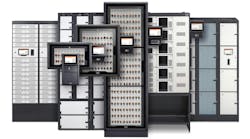The Internet of Everything: Infrastructure, IT and the Industrial Internet of Things
In this week’s Voices of the Industry, Samir Shah of BASELAYER explains how today’s data centers are no longer simple compute environments, but rather complex systems tying together physical infrastructure to the applications we consume on daily basis. In essence, the data center houses the ‘Internet of Everything,’ making it a valuable technology asset.
SAMIR SHAH, BASELAYER
Over the last year, many people have weighed in on how data center infrastructure will evolve to address the expanding appetite for content delivery along with the growing demand for billions of small information packets associated with the Internet of Things (IoT).
While traits like agile, sustainable, secure and software-defined are essential in the discussion, let’s consider how the data center will impact three major industry segments (1) Utility, (2) Telecommunication and (3) Colocation Service Providers. The goal is to outline how their choice in deployment model and technology will impact their ability to support today’s data/content explosion.
The Data Center – Yesterday
Before we dive forward into current trends, let’s consider important foundational events which influenced the evolution of the modern data center. Data centers first came into existence in the 1960s when American Airlines and IBM partnered to create a passenger reservation system known as Sabre. Computers cost about $5 million per unit and could be rented for $17,000 per month. The first data center contained two IBM mainframes and processed almost 100,000 telephone calls per day. This was the first time an enterprise data center was used to host a software platform and deliver a key business function.
From a resource perspective, the early data centers required power/water as inputs and delivered data/information as outputs. These outputs were contained within the four walls of the building and only added value to workplace consumers.
Graphic 1.1: First data centers had limited inputs and focused on delivering data to workplace consumers.
The Data Center – Today
Data centers today are far more complex. Water/power are still essential, but data center environments now require inputs including: networking, inbound applications and compute, just to name a few. On the output side, data centers still deliver data/information, however, they now enable services including business intelligence and ubiquitous cloud environments.
Individuals and enterprises consume these outputs by viewing stunning High Definition (HD) content through their phone or by machine-to-machine (M2M) interfaces, which interact with millions of sensor endpoints; Cisco estimates that M2M connections will more than triple over the next five years, growing to 10.5 billion by 20191. To put this growth into perspective, Sustainability Executive Patrick Flynn aptly calls the intricate web of expanding compute, storage and networking, “Mankind’s Biggest Story” in a recent TEDx talk.
Graphic 1.2: Data centers today are complex systems delivering data/insight to a host of consumers.
Graphic 1.3: Infographic summarizing the growing demand for data, content and insights.
Industry Impact
Based on the sheer volume of information, infrastructure providers will need to dynamically provision data center capacity based on individual application requirements. The resulting network is a series of large scale sites combined with edge locations working together to provide an optimized infrastructure system.
Let’s consider how three critical industry segments (1) Utilities, (2) Telecommunication and (3) Colocation Service Providers will address the delivery of data centers based on application/consumer demand.
Graphic 1.4: Large centralized data centers will be supplemented by optimized edge computing sites.
Utility Providers:
Power is to the digital revolution what coal was to the industrial revolution. Based on the power trends below, we see that utility providers hold the key to a constrained resource and therefore are going to play an expanding role in how data centers are delivered. A great example of a utility deployment model on the forefront of this movement is the DataStationTM concept deployed by Arizona based utility Salt River Project (SRP).
In this scenario, utility companies view compute, storage and networking capacity as a resources needed in their communities, no different than power or water. Utility providers will continue to support large scale enterprise/colocation deployments while leveraging transmission and/or distribution sites for alternative and sustainable edge capacity.
Graphic 1.5: EPRI estimates of US based data center power consumption by 2030
Telecom Providers:
Telecommunication providers are most in need of a scalable solution to address expanding content delivery. Residential and commercial customers located outside of primary metro network traffic are often subject to gaps in coverage; resulting in slow throughput conditions. In order to address these gaps, telecom providers supplement their network by installing low cost, low density, edge caching sites.
While this might be a short term stopgap, most of these sites are not capable of dynamic provisioning, nor are they well suited for sudden spot demand often attributed to video streaming. Additionally, advances in software-defined networking (SDN) are enabling abstracted/virtualized networks, which result in greater throughput using existing hardware. The tradeoff, SDN driven caching nodes will become more compute centric, therefore driving power densities higher based on variable demand.
Colocation Service Providers:
With all of this discussion of edge infrastructure, are large colocation facilities a thing of the past? The answer to this question is no. Colocation data centers will continue to act as central aggregation points in a “hub-and-spoke” model whereby consumers benefit from the inherent economies of scale.
However, consumers in these facilities still require transparency, control and eventually automation to allow applications to seamlessly move across all potential data center asset pools. We can envision a scenario in which event based triggers initiate a workflow designed to place IT resources ranging from another primary site, to an edge location, to a web-scale cloud environment. In order to achieve this level of infrastructure virtualization, colocation providers must deploy using underlying technology rich in functionality and designed with the application in mind.
Graphic 1.6: Data center infrastructure and IT work together to dynamically provision resources.
The Path Forward
In the past five decades, data centers have evolved, creating a unique opportunity for growth in the Utility, Telecommunications and Colocation Service Providers. Today’s data centers are no longer simple compute environments, but rather complex systems tying together physical infrastructure to the applications we consume on daily basis. By looking at how utility, telecommunication and colocation service providers support the Internet of Everything, we can conclude that data centers must be evaluated as technology assets. Rather than isolated, passive, elements of the IT supply chain. By doing so, industry leaders will ensure their organizations and their critical infrastructure are prepared to address the growing demands of the digital age.
Samir A. Shah is BASELAYER’s Vice President of Product Management and Marketing. Connect with Samir on LinkedIn or Twitter.


